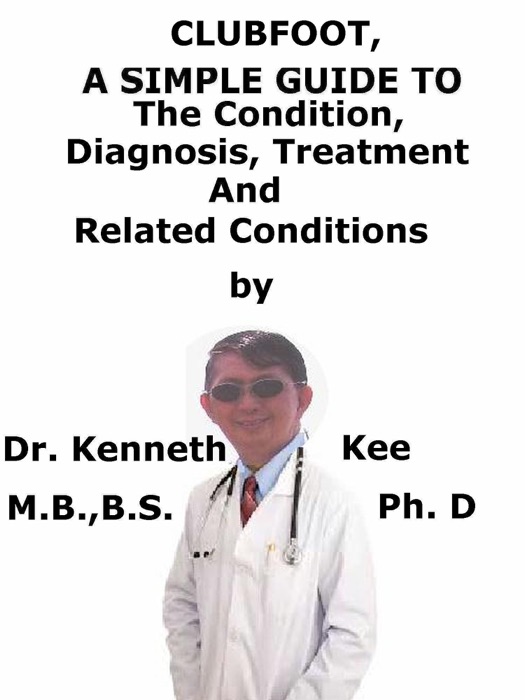[Download] ~ Clubfoot, A Simple Guide To The Condition, Diagnosis, Treatment And Related Conditions " by Kenneth Kee ~ Book PDF Kindle ePub Free

eBook details
- Title: Clubfoot, A Simple Guide To The Condition, Diagnosis, Treatment And Related Conditions
- Author : Kenneth Kee
- Release Date : January 13, 2018
- Genre: Health & Fitness,Books,Health, Mind & Body,Professional & Technical,Medical,
- Pages : * pages
- Size : 148 KB
Description
This book describes the Club Foot, Diagnosis and Treatment and Related Diseases
Clubfoot is a congenital medical disorder when the foot turns inward and downward.
It is not clear exactly what causes clubfoot.
In most cases, it is diagnosed by the typical appearance of a baby's foot after they are born.
If a baby has clubfoot, their foot has a typical appearance.
The foot points down at their ankle (doctors call this position equinus).
The heel of their foot is turned inwards (doctors call this position varus).
The middle section of their foot is also turned inwards and the foot seems quite wide and short.
It is fixed in this position and cannot be moved into a normal foot position.
The baby's foot is kept in this position because the Achilles tendon at the back of the baby's heel is very short and the inside tendons of their leg have also shortened.
If nothing is done to treat the problem, as the baby forms and begins to stand, they will not be able to stand with the sole of their foot flat on the floor.
Clubfoot is frequently broadly classified into two major groups:
1. Isolated (idiopathic) clubfoot is the most frequent form of the abnormality and happens in children who do not have any medical disorders.
2. Non-isolated clubfoot occurs in combination with other medical disorders or neuromuscular conditions such as arthrogryposis and spina bifida.
Symptoms
The physical shape of the foot may be different.
One or both feet may be involved.
1. The heel points downward, and the front half of the foot turns inward.
2. The calf muscles on the affected side are smaller than on the normal side.
3. The leg on the affected side is slightly shorter than on the other side.
4. The foot itself is usually short and wide.
5. The Achilles tendon is tight.
6. The foot turns inward and downward at birth; the child is unable to place the foot correctly.
Prenatal diagnosis
The clubfoot of the baby can be diagnosed before birth with ultrasound.
About 10 percent of clubfeet can be detected as early at 13 weeks in a pregnant woman.
Diagnosis after birth
Clubfoot is usually diagnosed after a baby is born.
All babies are routinely examined and checked over by a doctor shortly after they are born.
A foot x-ray may be done.
Computerized tomography scan (CT or CAT scan) may help.
There have been some changes to the treatment for clubfoot over recent years.
Major surgery was often a frequent treatment used.
The results of medical researches have indicated that other treatments without major surgery, especially a treatment known as the Ponseti method, appear to provide the best long-term treatment for most children.
Most cases of clubfoot are successfully treated with non-surgical methods that may include a combination of stretching, casting, and bracing.
Treatment usually begins shortly after birth.
Ponseti method should be started as soon as possible after birth when it is proven to be the easiest time to reshape the foot.
Gentle stretching and recasting is done weekly to normalize the position of the foot.
Generally, five to 10 casts are needed.
The final cast will stay in position for 3 weeks.
Once the foot is correctly in position, the child will wear a special brace nearly full time for 3 months.
The child will use the brace at night and during naps for up to 3 years.
Frequently the problem is a short tight Achilles tendon and a simple surgery is needed to release it.
Surgical Treatment
Surgery may be needed to correct the ligaments, tendons, and joints in the foot and ankle.
Even while many patients with clubfoot are successfully corrected with non-surgical methods, sometimes the deformity cannot be fully corrected or it returns, frequently because treatment program is difficult for parents to follow.
TABLE OF CONTENT
Introduction
Chapter 1 Club Foot
Chapter 2 Causes
Chapter 3 Symptoms
Chapter 4 Diagnosis
Chapter 5 Treatment
Chapter 6 Prognosis
Chapter 7 Foot Drop
Chapter 8 Cerebral Palsy
Epilogue